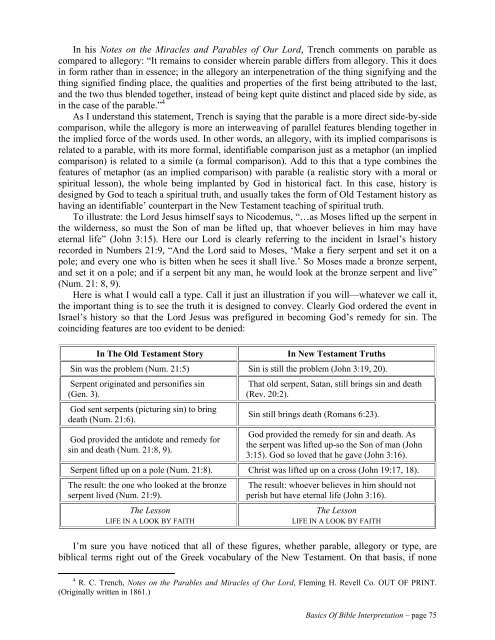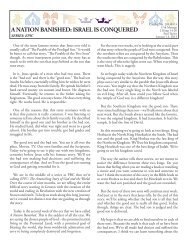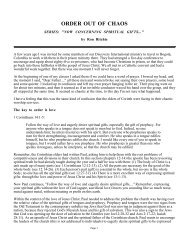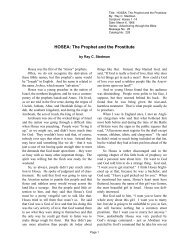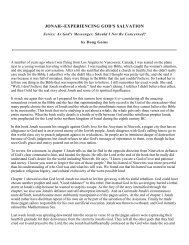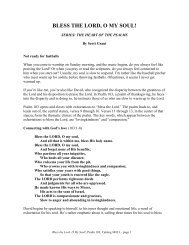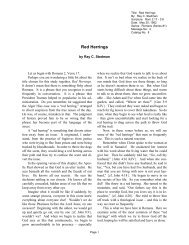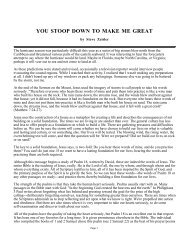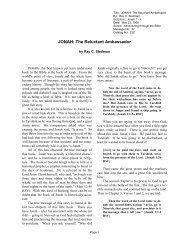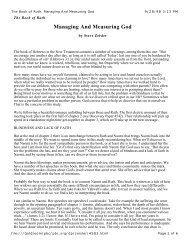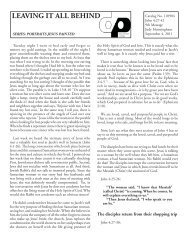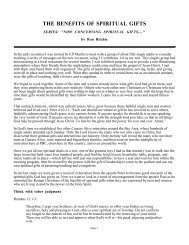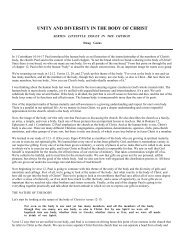Basics of Bible Interpretation - RayStedman.org
Basics of Bible Interpretation - RayStedman.org
Basics of Bible Interpretation - RayStedman.org
You also want an ePaper? Increase the reach of your titles
YUMPU automatically turns print PDFs into web optimized ePapers that Google loves.
In his Notes on the Miracles and Parables <strong>of</strong> Our Lord, Trench comments on parable as<br />
compared to allegory: “It remains to consider wherein parable differs from allegory. This it does<br />
in form rather than in essence; in the allegory an interpenetration <strong>of</strong> the thing signifying and the<br />
thing signified finding place, the qualities and properties <strong>of</strong> the first being attributed to the last,<br />
and the two thus blended together, instead <strong>of</strong> being kept quite distinct and placed side by side, as<br />
in the case <strong>of</strong> the parable.” 4<br />
As I understand this statement, Trench is saying that the parable is a more direct side-by-side<br />
comparison, while the allegory is more an interweaving <strong>of</strong> parallel features blending together in<br />
the implied force <strong>of</strong> the words used. In other words, an allegory, with its implied comparisons is<br />
related to a parable, with its more formal, identifiable comparison just as a metaphor (an implied<br />
comparison) is related to a simile (a formal comparison). Add to this that a type combines the<br />
features <strong>of</strong> metaphor (as an implied comparison) with parable (a realistic story with a moral or<br />
spiritual lesson), the whole being implanted by God in historical fact. In this case, history is<br />
designed by God to teach a spiritual truth, and usually takes the form <strong>of</strong> Old Testament history as<br />
having an identifiable’ counterpart in the New Testament teaching <strong>of</strong> spiritual truth.<br />
To illustrate: the Lord Jesus himself says to Nicodemus, “…as Moses lifted up the serpent in<br />
the wilderness, so must the Son <strong>of</strong> man be lifted up, that whoever believes in him may have<br />
eternal life” (John 3:15). Here our Lord is clearly referring to the incident in Israel’s history<br />
recorded in Numbers 21:9, “And the Lord said to Moses, ‘Make a fiery serpent and set it on a<br />
pole; and every one who is bitten when he sees it shall live.’ So Moses made a bronze serpent,<br />
and set it on a pole; and if a serpent bit any man, he would look at the bronze serpent and live”<br />
(Num. 21: 8, 9).<br />
Here is what I would call a type. Call it just an illustration if you will—whatever we call it,<br />
the important thing is to see the truth it is designed to convey. Clearly God ordered the event in<br />
Israel’s history so that the Lord Jesus was prefigured in becoming God’s remedy for sin. The<br />
coinciding features are too evident to be denied:<br />
In The Old Testament Story<br />
In New Testament Truths<br />
Sin was the problem (Num. 21:5) Sin is still the problem (John 3:19, 20).<br />
Serpent originated and personifies sin<br />
(Gen. 3).<br />
God sent serpents (picturing sin) to bring<br />
death (Num. 21:6).<br />
God provided the antidote and remedy for<br />
sin and death (Num. 21:8, 9).<br />
That old serpent, Satan, still brings sin and death<br />
(Rev. 20:2).<br />
Sin still brings death (Romans 6:23).<br />
God provided the remedy for sin and death. As<br />
the serpent was lifted up-so the Son <strong>of</strong> man (John<br />
3:15). God so loved that he gave (John 3:16).<br />
Serpent lifted up on a pole (Num. 21:8). Christ was lifted up on a cross (John 19:17, 18).<br />
The result: the one who looked at the bronze<br />
serpent lived (Num. 21:9).<br />
The Lesson<br />
LIFE IN A LOOK BY FAITH<br />
The result: whoever believes in him should not<br />
perish but have eternal life (John 3:16).<br />
The Lesson<br />
LIFE IN A LOOK BY FAITH<br />
I’m sure you have noticed that all <strong>of</strong> these figures, whether parable, allegory or type, are<br />
biblical terms right out <strong>of</strong> the Greek vocabulary <strong>of</strong> the New Testament. On that basis, if none<br />
4 R. C. Trench, Notes on the Parables and Miracles <strong>of</strong> Our Lord, Fleming H. Revell Co. OUT OF PRINT.<br />
(Originally written in 1861.)<br />
<strong>Basics</strong> Of <strong>Bible</strong> <strong>Interpretation</strong> – page 75


